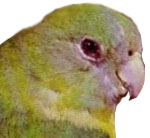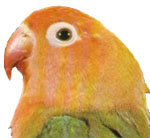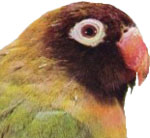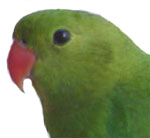 |
|
|
Species of Lovebirds |
|
The
lovebirds are classified as follows: |
|
Super
kingdom |
Eukaryota (organisms that have nuclei and organelles) |
|
Kingdom |
Metazoa (metazoans are organisms whose bodies are
composed of cells which differentiate into tissues and
organs) |
|
Phylum |
Chordata (chordates are animals with a dorsal central
nervous system) |
|
Class |
Aves (birds) |
|
Order |
Psittaciformes |
|
Family |
Psittacidae (parrots) |
|
Genus |
Agapornis (this name is taken from the Greek words for
"lovebird"). |
|
Species |
Agapornis cana |
Madagascar or
Gray-headed Lovebird
|
| |
Agapornis fischeri |
Fisher's
Lovebird |
| |
Agapornis lilianae |
Nyasa Lovebird |
| |
Agapornis nigrigenis |
Black-cheeked
Lovebird |
| |
Agapornis personata |
Masked lovebird
|
| |
Agapornis pullaria |
Red-faced Lovebird
|
| |
Agapornis roseicollis |
Peach-faced
Lovebird
|
| |
Agapornis taranta |
Abyssinian or
Black-winged Lovebird |
| |
Agapornis Swinderniana |
Swindern's or Black-collared
Lovebird |
| |
|
|
|
|
Madagascar
Lovebird Agapornis cana |
Back to Top |
|
Sometimes called the
gray-headed lovebird, This species is found on the island of
Madagascar. It has also been introduced to some other Indian Ocean
islands. The cock has a dark green back and wings, a light belly,
and the head and chest are whitish gray. The beak, legs, and feet
are light gray and there are black markings on the tail. The iris is
brown. The female is easily distinguished from the cock as she lacks
the gray patch on her forehead. These lovebirds are rarely seen in
captivity as there are export restrictions from their native
country. |
 |
|
Fischer's Lovebird
Agapornis fischeri
|
Back to Top |
|
This species comes from
northwestern Tanzania, south of Lake Victoria. The sexes are similar
in appearance, basically green, with light green on the under parts.
The forehead, cheeks and throat are bright orange, merging into
yellowish orange on the breast and nape of neck. The rump is blue
and there are blue, orange, and black markings on the tail. The beak
is red, the feet and legs gray. The irises are brown. This species
is fairly common, breeds readily, and a number of color mutations
have been developed. |
 |
|
Nyasa Lovebird Agapornis
lilianae
|
Back to Top |
|
This, and the remaining
species all possess a ring of feather free, white skin around each
eye, giving rise to the term the white eye-ringed group. The Nyasa
Lovebird is found in parts of Zambia Malawi and Rhodesia. The sexes
are similar in appearance. The back and wings are dark green, the
underside lighter with a yellowish tinge. The head, neck and breast
are a bright orange-red more vivid on the head, merging into
yellowish on the breast. The beak is red, the feet and legs gray and
the irises brown. Hens are said to be darker in color than the
cocks. |
 |
|
Black-cheeked Lovebird
Agapornis nigrigenis
|
Back to Top |
|
Found only in a small area of
Zaire, this species was extremely popular with aviculturists during
the 1920's when large numbers were captured. The sexes are similar
in color, the back is dark green, the under parts greenish yellow.
The forehead and crown are reddish brown, merging into black on the
checks. There is a band of orange on the upper breast and the nape.
The beak is red, the feet and legs grayish and the irises are brown.
Not common in captivity but breeds readily. |
 |
|
Masked Lovebird
Agapornis personata
|
Back to Top |
|
Found in Tanzania, but is in
the northeast, this species does not overlap the range of the
preceding species. The sexes are similar in appearance. The head is
a dark sooty brown. The wings are a dark green, the underside is
lighter. The breast and the nape of the neck are yellowish and the
flight feathers are black. The rump is a grayish blue. The beak is
red, the legs and feet gray. This species is fairly often seen in
captivity. |
 |
|
Red-Faced Lovebird
Agapornis pullaria
|
Back to Top |
|
This species is found in
equatorial Africa, ranging from Sierra Leone to Lake Albert in
Uganda. In the west of it's range it extends down as far as northern
Angola. The cock has a bright green body, verging into yellowish on
the under parts. The forehead and face are bright orange-red and
there are black flight feathers. The rump is blue and there are
small amounts of red, yellow and black in the tail feathers. The
beak is red , the feet and legs are gray and the eyes are brown. The
hen is similar in color but paler. |
 |
|
Peach-faced Lovebird
Agapornis roseicollis
|
Back to Top |
|
These are the most widely
kept of the lovebirds and are breed in large numbers not
surprisingly, several mutations have become established including
Pastel blue, yellow, Lutino and Pied. The normal cock and hen are
similar in color, except that the hen may be a bit paler. The body
is olive green, lighter on the belly. The head, throat and breasts
are a bright peach pink. The flight feathers are black and there are
red, blue, and black markings in the green tail feathers. |
 |
|
Abyssinian Lovebird
Agapornis taranta
|
Back to Top |
|
Another name for this species
is the Black-winged Lovebird. It is found in central and eastern
Ethiopia and southern Eritrea, where it inhabits quite high
altitudes. The cock is mainly green, with a bright red forehead,
which extends into a narrow ring around the eyes. The flight
feathers are sooty black and there is a black bar on the tail. The
beak is red, the legs and feet are gray. The hen is green all over,
darker on the back lacking the red and black markings of the cock.
They are occasionally available on the market, but are one of the
most difficult species to breed. |
 |
|
Swindern's Lovebird
Agapornis swinderniana
|
Back to Top |
|
One of the rarest lovebird,
This species is rarely seen in captivity. There are three subspecies
known which occur in Liberia, the Cameroon and Zaire. The sexes are
similarly marked; mainly green with a characteristic half collar at
the nape. The chest is orange-yellow, merging into yellow on the
bell. The rump and tail have blue and red markings. The beak, feet
and legs are gray, the iris yellow. |
 |
© 2004 The GTLoveBird, Inc. All rights reserved.
Terms of Use and Disclaimer |
|
|
Grouping the Lovebird Species
There are different ways of grouping these lovebird species. A popular
method separates lovebirds in four groups, according to similarities
between each species. These groups are: Sexually Dimorphic,
Eye-ringed, Intermediate, and Black-cheeked.
The Sexually Dimorphic group consists of the Red-faced,
Abyssinian and Madagascar lovebirds, because the sex of a lovebird can
be determined by its coloring in these species.
The Eye-ringed group is made up of the Masked, Fischer's, Nyasa
and Black-cheeked species, as they all have an eye ring.
Peach-faced species is known as an Intermediate group, because
it shares some traits with both the Eye-ringed and Sexually Dimorphic
groups, but Peach-faces are not sexually dimorphic and do not have an
eye ring.
Black-cheeked group, the least known species, are placed into
their own group, because they do not fit into any of the other groups.
Some experts believe that the Sexually Dimorphic group is the most
ancient, and that the other species evolved from that group. Some
people think that the lovebird's closest relations are the Hanging
Parrots, while others think that lovebirds are more closely related to
the African and Indian Ring neck, King parrot and Eclectus group. Back To Top |
|
Mutations and Hybrids
Mutations are organisms that differ from the
normal, in color or some internal or external form. Mutations are
common in all organisms. In lovebirds, they are influenced by factors
such as a change in habitat or food supply, and caused by a change in
the DNA. As a result, the lovebird mutation may have a different type
of coloring. Mutations occur in captivity as well as in the wild.
Breeders use controlled inbreeding to produce new mutations and
colors. There are so many lovebird mutations that there is a great
variety of colors to choose from. A new lovebird mutation is usually
rare and expensive.
A hybrid is a cross between two different species that results in a
sterile animal. For example, crossing a horse and a donkey produces a
mule. Crossing two different lovebird species, such as the Peach-faced
and Nyasa, produces a lovebird that is unable to reproduce. Breeding
hybrids is strongly discouraged, because hybrids are perceived as
degradations of the gene pool, and are disqualified from bird shows. Back To Top |
|